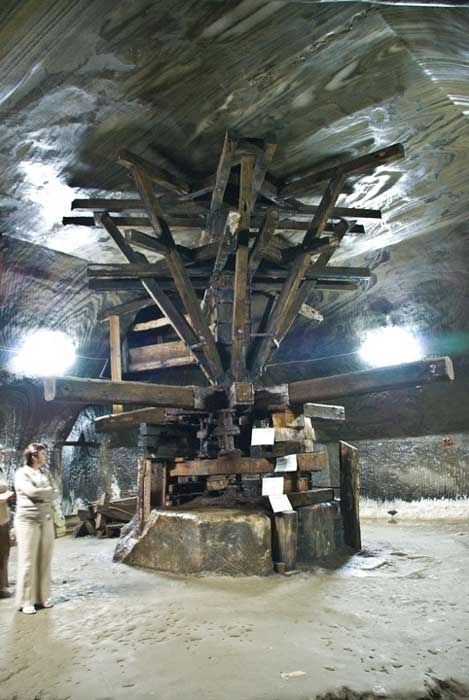
Salina Turda: From Medieval Salt Mine to Subterranean Theme Park
Salina Turda is a salt mine located in the Durgău-Valea Sărată area of Turda, which is a city in Romania’s Cluj County. Salt extraction at Salina Turda began during the medieval period, and continued up until the beginning of the 20th century. It was closed for some years, before being re-used during the Second World War, though not for the purpose of mining salt. The Salina Turda continued to be used in the following decades, though it was during the 1990s that the mine underwent its greatest transformation yet. Unlike many historical sites, which are usually turned into museums, the Salina Turda is today not only a museum of salt mining, but is also a subterranean theme park that is known not only in Romania, but also outside of that country.
The History of Salt Mining in the Area
The systematic mining of salt in Romania is recorded to have begun with the Roman occupation of that region (then known as Dacia). Archaeologically speaking, however, there is a lack of material evidence for this activity. This is due to the fact that such remains, e.g. shafts and galleries, would have been destroyed by future mining activities.
- The enormous and ancient Salt Mines of Khewra, said to be found by horse of Alexander the Great
- Salt: Treasure of the Ancient World and Highly-Valued Currency of the Roman Empire
- Preserved by Nature: Studying the Spectacular Salt Mummies of Iran

Durgău and the lakes from an old mining site from Salina Turda. (CC BY-SA 3.0)
Salt mining in the region continued into the medieval period. In a 1075 document from the Hungarian chancellery, reference is made to Transylvania, and the salt mines near the fortress of Turda are also mentioned. In another document from the chancellery, dated to the 1st of May, 1271, the salt mines of Turda are mentioned explicitly. References to the salt mines of Turda continue to appear in documents from the Middle Ages. The extraction of salt made the owners of these mines incredibly wealthy.
Sights in the Mine
Salt mining continued into the modern period, and the areas of the Salina Turda that can be visited by tourists today are the result of mining activities carried out during the 19th century.

The crivac is one of the main points of interest in the salt mine. (CC BY-SA 3.0 ro)
For example, one of the sections in the Salina Turda is known as the Franz Josef Gallery. Construction of this horizontal gallery began in 1853, and was intended to reduce the cost involved in bringing the salt to the surface of the mine. When it was completed in 1870, the gallery was 780 m (2559 ft.) long, and a further 137 m (449 ft.) was added to it by the end of the same century.

Franz Josef (old entrance) (CC BY-SA 3.0)
Another area of the mine that dates to the 19th century is the Rudolf mine. This was the last mine in the Salina Turda from which salt was extracted, and is 42 m (137 ft.) deep, 50 m (164 ft.) wide, and 80 m (262 ft.) long. This mine is connected to the extraction shaft room, where the extracted salt was transported vertically via a pulley tower shaft.
In this mine, salt stalactites that have formed over the years can also be seen. It has been stated that the stalactites grow at a rate of about 2 cm (0.79 inches) per year, and that when they reach a length of about 3 m (9 ft.), they break because of their own weight. There is also an underground lake in the area known as the Terezia Mine. This mine is 120 m (393 ft.)) deep, and the lake is between 0.5 and 8 m (1.6 and 26 ft.) in depth. In the middle of this lake is a 5 m (16 ft.) high island, which was formed by the salt waste that was dumped into the lake over the decades the mine was in operation.
- Once an Ancient Mine, The Breathtaking Underground Salt Cathedral of Colombia
- Silver Mines Within an Ancient Town Shed New Light on the Rich History of Greece
- Timeless Stories Built on Grains of Salt: Examining the Masterpieces within a Polish Salt Mine

Inside Salina Turda. (CC BY 2.0)
Salina Turda was closed in 1932, and was abandoned until the Second World War. During the war, the mines were used as an aircraft shelter. Though salt mining did not continue after the war, Salina Turda continued to be used. The Franz Josef Gallery, for example, became a storage room for cheese.
It was in 1992 that Salina Turda was opened as a salt mining museum and an underground theme park to the public. The theme park includes an amphitheater, a Ferris wheel, sports facilities, paddle boats on the lake in the Terezia Mine, and even a spa and wellness center. In an article published in 2016, the site is reported to attract around 60,0000 visitors a year, an indication of its popularity.
Top image: A view of the Rudolf Mine in the Salina Turda. Source: CC BY-SA 4.0
By Wu Mingren
References
Avakian, T., 2015. This enormous underground salt mine in Romania has been converted into an incredible amusement park. [Online]
Available at: http://www.businessinsider.com/salina-turda-amusement-park-in-romania-2015-7
Hudson, D., 2013. salina turda salt mines turned subterranean history museum. [Online]
Available at: http://www.designboom.com/architecture/salina-turda-salt-mines-turned-subterranean-history-museum-11-30-2013/
Kuriositas, 2013. Salina Turda: Romania’s Amazing Salt Mine turned Museum. [Online]
Available at: http://www.kuriositas.com/2013/12/salina-turda-romanias-amazing-salt-mine.html
Lynch, A., 2016. Pictures show giant theme park hidden 400 feet underground in Romania’s salt mines. [Online]
Available at: http://metro.co.uk/2016/03/21/pictures-show-giant-theme-park-hidden-400-feet-underground-in-romanias-salt-mines-5766003/
oliviasorlescu, 2017. Salina Turda. [Online]
Available at: http://www.atlasobscura.com/places/salina-turda
salinaturda.eu, 2013. Salina Turda. [Online]
Available at: http://salinaturda.eu/?lang=en















